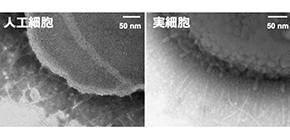
Fibrous artificial cells can be used as artificial cell catalysts
A group of researchers from Nagoya University and Osaka University, in cooperation with the Japan Advanced Institute of Science and Technology, created artificial cells with fibrous structures covered with AtaA, the adhesive bacterionanofiber protein localized on the cell surface of Acinetobacter sp. Tol 5, by combining a phospholipid and a protein.
AtaA belongs to a Trimeric autotransporter adhesin (TAA) discovered in a sticky Gram-negative bacterium, Acinetobacter sp. Tol 5.
In bottom-up synthetic biology, an approach to create truly artificial life de novo , various artificial cells were produced; however, the construction of surface-decorated artificial cells harboring enzymes that adhere to solid surfaces by mimicking the bacterial cell surface has not yet been achieved. This is because (1) it is difficult to synthesize proteins on the bacterial cell surface, which mostly contains transmembrane or membrane interacting domains, and (2) complex protein secretion machineries are necessary for the synthesis.
Natural bacterial cells use transport machineries to secrete and assemble huge cell appendages on the cell surface. As it is impossible to reconstruct such complex molecular machineries on artificial cells, this group tried to cover the surface of liposomes with AtaA. Specifically, they deleted AtaA’s signal peptide, which are not essential for its adhesive function, generating a truncated AtaA, NheadNstalk (NhNs)-AtaA in E. coli .
The researchers created liposomes containing a benzylguanine (BG) derivative-modified phospholipid, decorating them with a truncated AtaA protein fused to a SNAP-tag. This enables reconstitution of artificial cells with AtaA fibers simply by mixing (a) the supernatant of a cell lysate from E. coli harboring NhNs-AtaA-SNAP and (b) BG-modified cell-size liposomes.
Thus, the group reconstituted cell surface with fibrous structures by decorating cell-sized liposomes with AtaA. Electronic microscopy showed many nanofiber fibrous structures on the surface of BG-liposomes, which resembled features of Acinetobacter sp. Tol 5.
Artificial cells covered with AtaA fibers exhibited adhesion to solid surfaces with different physicochemical properties, performing a hydrolysis reaction catalyzed by an encapsulated enzyme.
Mimicking the cellular functions with defined molecules in this study can be used for characterization and functional analyses of not only AtaA but also other peripheral membrane proteins. It will become possible to analyze target proteins without interference from other cell surface components under a cell-mimicking environment.
Artificial cells constructed in this study can be used as immobilized catalysts as is the case with enzymes and microorganisms. Since artificial cells don’t multiply, it is thought that they will have a small impact on biodiversity, even if they escape into the nature. Thus, living cells immobilized onto solid supports can be used in the open environment where immobilized microorganisms cannot be used as catalysts.
Figure 1
Figure 2
Figure 3
The article, “Bottom-up creation of an artificial cell covered with the adhesive bacterionanofiber protein AtaA,” was published in Journal of the American Chemical Society at DOI: https://doi.org/ 10.1021/jacs.9b09340 .
Related links
